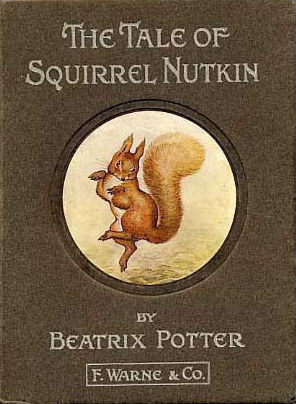The Tale of Squirrel Nutkin facts for kids

First edition cover
|
|
| Author | Beatrix Potter |
|---|---|
| Illustrator | Beatrix Potter |
| Country | England |
| Language | English |
| Genre | Children's literature |
| Publisher | Frederick Warne & Co. |
|
Publication date
|
August 1903 |
| Media type | Print (Hardcover) |
| Preceded by | The Tale of Peter Rabbit |
| Followed by | The Tailor of Gloucester |
The Tale of Squirrel Nutkin is a fun children's book. It was written and illustrated by Beatrix Potter. The book was first published in August 1903 by Frederick Warne & Co. The story is about a cheeky red squirrel named Nutkin. He has a very close call with an owl called Old Brown. This book came out after Potter's super popular The Tale of Peter Rabbit. It quickly became a big hit too! This book also introduced the familiar pictures on the inside covers of all the Peter Rabbit books.
The idea for Squirrel Nutkin came from a story and a letter with pictures. Beatrix Potter sent these to Norah Moore. Norah was the daughter of Potter's old teacher. The pictures in the background of the book show places like Derwentwater and St. Herbert's Island. These are real places in the beautiful Lake District in England.
Nutkin's Adventure
The story is all about Nutkin, a little squirrel, and his big family. When autumn arrives, they start getting ready for winter. Nutkin, his brother Twinkleberry, and their many cousins plan to gather nuts. They decide to go to a place called Owl Island. To get there, they build small rafts from twigs. Then they sail across the lake!
Owl Island belongs to a tawny owl named Old Brown. To get permission to collect nuts, the squirrels bring Old Brown gifts. Their first gift is three dead mice. But Nutkin doesn't help. Instead, he dances around and sings a silly riddle. Old Brown doesn't pay much attention to Nutkin. He lets the other squirrels start their work.
The next day, the squirrels give Old Brown a large mole. Nutkin is still rude and tells more riddles. He still doesn't help gather nuts. On the third day, the squirrels go fishing. They catch seven small fish called minnows. They give these to Old Brown. Nutkin again says a riddle, which starts to annoy Old Brown.
On the fourth day, the squirrels bring Old Brown six beetles. Nutkin sings another riddle. Old Brown is getting quite bothered now. On the fifth day, the squirrels bring a lot of sweet honey. They had taken it from a bumblebee hive. But Nutkin still teases Old Brown with a riddle. He also doesn't gather nuts. He plays bowling with an apple instead.
Finally, on the sixth and last day, the squirrels bring Old Brown a fresh egg. Old Brown is thankful for all the gifts from the other squirrels. But he is very annoyed with Nutkin. Nutkin has been teasing him with riddles and hasn't done any work. The owl grabs Nutkin by his tail! He drags him into his treehouse. This scares all the other squirrels. Old Brown tries to hurt Nutkin. But Nutkin uses all his strength to escape!
Nutkin gets away, climbing out the top of the tree. But he realizes his tail is gone! Old Brown has it, and Nutkin can never get it back. After this scary moment, Nutkin hates all riddles. If anyone ever asks him a riddle, he will throw sticks and start shouting!
How the Book Was Made
Beatrix Potter spent her summer holiday in 1901 at a place called Lingholm. It's in the beautiful Lake District. While she was there, she sent a story and a picture letter to Norah Moore. The letter was about a group of red squirrels living in Cumberland.
Potter spent that summer drawing squirrels. She also sketched the land around Lingholm. She drew St. Herbert's Island, which became Owl Island in the book. St. Herbert's Island is in the middle of Derwentwater lake. Potter drew and took photos of the island. She captured Old Brown's twisted tree and the forest floor. The tree stayed there for many years after her visit.
Beatrix Potter enjoyed working on a few story ideas at once. In November 1902, she gave her publisher, Norman Warne, a version of her squirrel book. He liked it and told her to keep drawing the squirrels.
Images for kids



